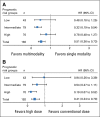Brain Metastases in Patients With Germ Cell Tumors: Prognostic Factors and Treatment Options--An Analysis From the Global Germ Cell Cancer Group
- PMID: 26460295
- PMCID: PMC5070579
- DOI: 10.1200/JCO.2015.62.7000
Brain Metastases in Patients With Germ Cell Tumors: Prognostic Factors and Treatment Options--An Analysis From the Global Germ Cell Cancer Group
Abstract
Purpose: To define characteristics, treatment response, and outcomes of men with brain metastases (BM) from germ cell tumors (GCT).
Patients and methods: Data from 523 men with BM from GCT were collected retrospectively from 46 centers in 13 countries by using standardized questionnaires. Clinical features were correlated with overall survival (OS) as the primary end point.
Results: BM were present at initial diagnosis in 228 men (group A) and at relapse in 295 men (group B). OS at 3 years (3-year OS) was superior in group A versus group B (48% v 27%; P < .001). Multiple BM and the presence of liver or bone metastasis were independent adverse prognostic factors in both groups; primary mediastinal nonseminoma (group A) and elevations of α-fetoprotein of 100 ng/mL or greater or of human chorionic gonadotropin of 5,000 U/L or greater (group B) were additional independent adverse prognostic factors. Depending on these factors, the 3-year OS ranged from 0% to 70% in group A and from 6% to 52% in group B. In group A, 99% of patients received chemotherapy; multimodality treatment or high-dose chemotherapy was not associated with statistically improved survival in multivariable analysis. In group B, only 54% of patients received chemotherapy; multimodality treatment was associated with improved survival compared with single-modality therapy (hazard ratio, 0.51; 95% CI, 0.36 to 0.73; P < .001), as was high-dose compared with conventional-dose chemotherapy (hazard ratio, 0.41; 95% CI, 0.24 to 0.70; P = .001).
Conclusion: Men with BM from GCT have poor OS, particularly if additional risk factors are present. High-dose chemotherapy and multimodality treatment seemed to improve survival probabilities in men with BM at relapse.
© 2015 by American Society of Clinical Oncology.
Conflict of interest statement
Authors' disclosures of potential conflicts of interest are found in the article online at www.jco.org. Author contributions are found at the end of this article.
Figures





References
-
- The International Germ Cell Cancer Collaborative Group. International germ cell consensus classification: A prognostic factor-based staging system for metastatic germ cell cancers. J Clin Oncol. 1997;15:594–603. - PubMed
-
- The International Prognostic Factors Study Group. Prognostic factors in patients with metastatic germ cell tumors who experienced treatment failure with cisplatin-based first-line chemotherapy. J Clin Oncol. 2010;28:4906–4911. - PubMed
-
- Forquer JA, Harkenrider M, Fakiris AJ, et al. Brain metastasis from non-seminomatous germ cell tumor of the testis. Expert Rev Anticancer Ther. 2007;11:1567–1580. - PubMed
-
- Boyle HJ, Jouanneau E, Droz JP, et al. Management of brain metastases from germ cell tumors: A single center experience. Oncology. 2013;85:21–26. - PubMed
MeSH terms
Grants and funding
LinkOut - more resources
Full Text Sources
Other Literature Sources
Medical

